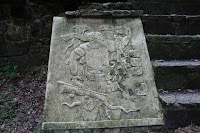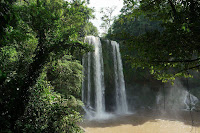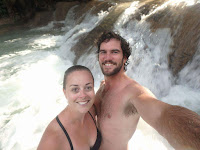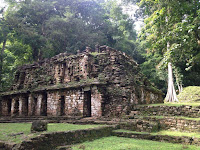The ADO bus ride between San Cristobal and Palenque was a nice short 3 hour direct route through the state of Chiapas... or so we thought! Somehow our bus selection included a route that was anything but direct. Instead it deviated nearly all the way out to the Gulf of Mexico as we passed through the city of Villahermosa. Although this added roughly four hours on to our travel time, we did get to experience some nice mountainous jungle scenery as we skirted through the seaside province of Tabasco.
Finally we arrived to Palenque and checked in to our hotel, the Maya Tulipanes, a little fancier than what we had been used to! We were excited as the town of Palenque was located on the edges of the last remaining rainforest jungle in North America, giving us our first taste of a more tropical climate and scenery. With plenty of activities on offer we had a full schedule for the few days we would be staying in town.
First up was to pay a visit to the nearby archaeological site, also called Palenque, 9 kilometres down the road. We decided we would try to beat the crowds so we got up early to catch a collectivo that got us to the entry point right at the opening time of 8am. The first thing noticed about the site was the beautiful jungle surrounds. While Palenque town is on the edge of the jungle, the Palenque ruins are set deep in its midst.
The lush green backdrop sets the scene for the multiple temples, all in various stages of excavation and reconstruction, scattered throughout the site. Right as you enter you encounter several massive buildings, including the Temple of Inscriptions and the Temple of the Count, that really show off how magnificent this city would have been at its peak. Palenque was a medium sized Mayan city, home to over 7,000 people, that served as a capital for the region and had a long running rivalry with many of the surrounding Mayan cities.
Palenque thrived between the years 200BC and 800AD before being abandoned to the jungle. There are around 100 restored structures and temples, some safe enough to be climbed to the top, in order to gain a great birds eye view. Interestingly it is estimated that only around 10% of this ancient city has been excavated, leaving in the vicinity of 1000 structures still uncovered and unexplored in the jungle.
Our tactic of arriving early worked perfectly and for the first hour or so, we had the majority of the site to ourselves, giving the experience a more mystical air. Luckily for us we had also beaten all the local merchants who were laying their out their stalls of cheap and garish trinkets along all of the major thoroughfares. All of a sudden around 9'o'clock the ruins were filled with the sounds of the merchants hawking their wares and blowing incessantly on wooden whistles moulded to sound like either bird calls or jaguar roars.
Content that we had seen the best of the ruins we looped down through the southern courtyard on our way to the exit when we heard another sound echoing out over the site. It was a strange booming roar, and was so constant we originally thought it was yet another device being sold by the stall owners. We were very mistaken though as we all of a sudden caught a glimpse in the canopy of the surrounding jungle - black howler monkeys, the source of the roars!
We headed over to try for a closer look. We were promptly rewarded by several of the troupe heading down to the lower branches as they foraged for food. We hung around for another half hour or so, watching these interesting little creatures jumping and playing in the trees before finally heading out and back to our hotel.
On the ride back along the 9km jungle lined road we spotted a few signs that caught our interest. A little locally run zoo, Ecoparque Aluxes, featuring animals from the state of Chiapas. We did a little research and discovered this zoo was actually a rescue and rehabilitation centre for injured, orphaned and ex-black market animals. With an entry price of only ten Australian dollars we decided to head there the next day and check it out.
We walked the 3 kilometres down the road to Aluxes the next morning, where we purchased our entry tickets at the front desk. Here we found we had the choice of several amazing sounding activities also available at a very low cost. We selected a couple from the list. Holly bought a manatee encounter, I bought a crocodile encounter and we both went in for a session with a Scarlet Macaw.
The centre's inhabitants included several jaguars, parrots, monkeys, deer and peccaries - but the real highlight was the animal encounters! First up we visited the manatee pond where Holly got to feed and pat four rare West Indian manatees as they bobbed up and down in their muddy lagoon. Each of these manatees had been rescued and nursed back to health after collisions with boats in the surrounding area. It was amazing watching their whiskered heads jostling for positions as they chomped on a variety of vegetables.
Next we stopped at the crocodile pens. The zoo had several species of crocodilians including Spectacled Caimans and the smaller Morelets species, but it was the larger American Crocodile exhibit where I got to have my encounter. A zoo volunteer was waiting with several chunks of meat which we loosely attached to a long stick by a piece of twine. One by one I lowered the pieces of meat into the enclosure, in a fishing type manner and the hungry crocodiles below jostled as they snapped at the meat.


After completing a full circuit of the exhibits we stopped at a the kiosk area for our final animal interaction. Here there were several noisy species of macaws hanging on perches around the edges of the building. The keeper handed us each a handful of sunflower seeds and each of us were handed a beautiful Scarlet Macaw that perched on our arms and ate the seed out of our hands. Up close these colourful birds are quite large, with powerful beaks capable of easily crushing a variety of seeds and nuts! It was a great experience and one that was even more special after we were told the story of the history of macaws in the area.


Sadly the local Chiapas population of Macaws went extinct in the 1940s thanks to the pet trade and the clearing of land for farming. However, due to the breeding efforts of Aluxes, in 2014 the Scarlet Macaw was successfully integrated back into the wild. As the program continues the wild population will only continue to grow. The park really completely exceeded all of our expectations and it was a great experience to see so many of these local animals up close.
Very satisfied with our day we hitched a ride back to town as a tropical downpour set in. Before returning to our hotel we booked in a couple of tours for the next two days in order to visit some of the more distant Chiapas attractions.
First up we took an afternoon tour out to two of the major waterfall sites in the state, Misol-Ha and Agua Azul. Misol-Ha was located an hour west of Palenque, in a dense jungle area. We had a short hike down to a smallish pool of water that featured a 35 metre noisy single drop waterfall. It was quite beautiful and could be viewed by several different angles, including a short path that took you behind the crashing cascade where a dense mist constantly hung in the air. The water of Misol-Ha, like much of the surrounding area, is a beautiful blue colour due to the high mineral content. However, it was a little brown when we were there due to recent heavy rains.


After taking in the view from every possible angle we all piled back in to the van for another hours drive further west to Agua Azul. This site could not have been more different to the first, instead of one waterfall, there were hundreds, all of assorted shapes and sizes, created as the Shumula river cascades over more than a kilometre of boulders and other natural obstacles. Like several of the more touristy areas we had visited there were many small shops and stalls set up along the western bank all filled with snack ands trinkets, with owners loudly spruiking their wares.
We hiked up the bank for a few hundred metres until we came to somewhere a little more peaceful and we're lucky enough to find a small natural pool, complete with waterfall, that we had all to ourselves. We swam in the delightfully refreshing waters for around an hour, even challenging ourselves to swim all the way up to the gushing waterfall itself. Quite a challenge as the force of the water was very strong even with its small size. Afterwards we had time to explore a few more of the upper pools and falls, all surrounded by beautiful lush jungle, before it was time to head back down to the shuttle returning us to the town.
For our last day in the area we headed out on the second, and much larger, of our two day trips. We were picked up from the front of our hotel at around 5am and immediately commenced the drive southwards in to the denser jungles of Chiapas. We stayed on the small, rough roads for around 3.5 hours, not including a stop for a locally styled breakfast, at a small rustic cafe. Along the way we passed through several tiny villages and encountered multiple traffic obstacles including children, dogs, chickens, turkeys, pigs and vultures! Our driver wasn't too concerned as it all seemed to be a pretty typical day on the backstreets of Mexico!
We finally arrived to our destination, the Usumacinta river, that marks the border between Mexico and Guatemala. Here we would be catching a boat downriver to the Mayan ruins of Yaxchilan. Approximately an hour and twenty minutes away.
Yaxchilan was another regional capital and one of many rivals to Palenque. It has actually been documented that the two cities fought in a bloody war in the middle years of the 7th century. These boat rides are the only way to access these ruins as there are no roads within 50 miles of the site, which made the entire trip feel a lot like a real adventure!
After a couple of slight engine troubles, we made it to the ruins site and scrambled up the steep riverbanks to the site entrance. It was a short and muddy hike through wild jungle before we reached the first of the ancient structures known as 'the labyrinth'. Immediately we felt some strong Indiana Jones explorer vibes, with the jungle setting and moss covered rock temples all around us, dappled in sunlight.


The labyrinth is named for the small collection of tunnels that serve as an entrance to the grand courtyard beyond. With the lights of our phones guiding the way, we navigated through the maze. Tiny bats were hanging from the ceiling and occasionally flapping through the corridors, all adding to the feeling that we were venturing to somewhere barely travelled by the modern day explorer!
The courtyard on the far side was a huge opening in the otherwise dense jungle, with smallish structures running along three sides. On the fourth side, the side furthest away from the river, ran a huge stone staircase up a natural hill. At the top of this hill was the ancient religious temple of the city, the imaginatively named Structure 33! The most noticeable element of the temple was the intricate latticework adorning the top, really setting it apart from most of the other ancient ruins we had seen.


Adding to the adventurous vibes of the place, were the constant roars of the howler monkeys inhabiting the surrounding region, as well as a family of acrobatic spider monkeys noisily leaping from tree to tree as the grazed through the canopy.
Still present in Yaxchilan were several elaborate stone carvings that had somehow survived the rough jungle conditions of the last few centuries to still be recognisable today. No small feat! After a couple of hours exploring we were back on the boat and on our way to meet the shuttle for the second stop of the day.
After a quick bite to eat for lunch we arrived to the site of Bonampak in the mid afternoon. Bonampak is located deep in the biosphere reserve of Montes Azules, meaning another beautiful jungle setting. The site itself is nothing too out of the ordinary, a large clearing/courtyard area with some small bordering structures and another set of stairs running up a hill on the northern side. The feature that really makes Bonampak special is what can be found in three small temples half way up the staircase. The most well preserved ancient murals in the entirety of the Americas!
Each decoration of the three rooms is slightly different. Every interior wall is covered on all four sides by various scenes of day to day Mayan life. These included dancing, musical performances, receiving tributes, warfare, and human sacrifice! All of these activities are amazingly still completely recognisable in untouched detail.


The thing that really stood out the most was the colours. Bright reds, blues, greens and yellows. All completely amazing for murals that date back to the timeframe of 700 to 800AD. These rooms are believed to have been a visual documentation of the history of the site, in particular the glorious victories won over several rival cities.
After admiring each of the mural rooms and spending a few minutes just sitting at the top of the stairs admiring the birds eye view of the courtyard and surrounding jungle, we piled back into our van and the long drive back to Palenque. Our arrival time back to the hotel was 7pm. A huge day of 14 hours out exploring the historic jungle sights of Chiapas, but certainly one of our favourite experiences of the country so far!


Sadly our time in Palenque had come to an end and after one last night in our hotel we were ready for the journey north to the Yucatan.
Adrian.












































Another fantabulous blog ,well done looks lije an amazing place xx mum
ReplyDeleteDefinitely one our highlight places for Mexico. Xx
Delete